Book Reviews
Homage to an adopted land
Potpourri
Poet: Hemakumar Nanayakkara
Vijitha Yapa Publication
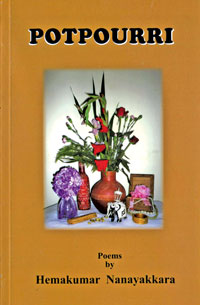 âPotpourriâ it is called and a potpourri it truly is. This delightful
slim bound book is a compilation of 60 fictional and non-fictional poems
by Hemakumar Nanayakkara on diverse subjects ranging from nature to life
and sentiments. âPotpourriâ it is called and a potpourri it truly is. This delightful
slim bound book is a compilation of 60 fictional and non-fictional poems
by Hemakumar Nanayakkara on diverse subjects ranging from nature to life
and sentiments.
The poet had drawn inspiration from his adopted country Europe: its
green landscapes, cool climate and society. His experience of working in
a nursing home for over 16 years in the Swedish environment nurtured the
ideas in his mind, taking shape of verses which he penned down on paper.
These experiences he brings before the readers of his motherland through
the lines flowing out of his pen.
An old boy of Ananda College, Colombo, Nanayakkara had enrolled at
the University of Colombo for a science degree. After a brief spell he
went overseas for higher studies. One of his primary interests had been
to pursue literature. This interest helped him to sharpen his flair for
creative writing.
The poetâs love and admiration of the countryside is reflected
through poems like âSpringâ, âIsland of Paradiseâ, âQueen of Rainâ etc.
He displays his ability to take note of minute detains as these are
highlighted through his words painting a vivid picture before the
readers.
The pictures included in the book, taken by the poet himself in his
ventures helps to highlight his verses.
Though the poet is fluent in a number of languages, especially the
German language, it is pleasing to note that this had not weakened his
ability to express deep sentiments through the English language. The
poems are each distinct from the other for originality is the underlying
theme.
âPotpourriâ is bound to bring pleasure for any poetry lover and is
the poets own method of paying homage to a land which had taken him
under its beauty and protection in the past few years.
- Ruwini Jayawardana
The most important teaching of The Buddha
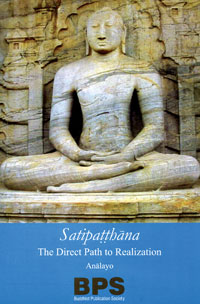 This book is based on the personal experience gained through years of
meditation by the author and a research the author engaged himself for
his PHD at Peradeniya University on Satipatthana Sutta Listed in Diga
Nikaya and Majjima Nikaya which is said to be the most important
discourse on the path to Liberation, delivered in Kammasadhamma in
Kururata which corresponds to the present Dhili in India. This book is based on the personal experience gained through years of
meditation by the author and a research the author engaged himself for
his PHD at Peradeniya University on Satipatthana Sutta Listed in Diga
Nikaya and Majjima Nikaya which is said to be the most important
discourse on the path to Liberation, delivered in Kammasadhamma in
Kururata which corresponds to the present Dhili in India.
In this work author simply but lucidly make it reflect how a
phenomenon comes into being depending on the combination of conditions
and components and how it disintegrate itself with the change of the
conditions and the components sustaining the combination the phenomenon
is based on, and the guidelines on the contemplation on body, feeling,
mind and dhammas (For which English one word equivalent is not given in
this book) leading up to the realisation of the four noble truths which
is essential to penetrate in to the real nature of our existence.
On this realisation it is convinced that true and permanent happiness
cannot be kept up at all, by possessing and pursuing after material
gains and worldly achievements. And happiness is based on mental
purification and cultivation of wisdom by distancing oneself from all
the evil actions and engaging oneself in all the meritorious actions and
controlling of oneâs mind.
On this discourse it is elicited that meditation is essential for
true purification of mind based on four noble truths. Which is the most
important teaching of the Buddha.
For that matter Buddhaâs first discourse Dammachakka Sutra delivered
in Saranath to his first five disciples is also based on four noble
truths; i.e. Truth of Dukka Truth of the end of Dukka, Truth of the path
that should be taken to the end of Dukka. (suffering)
This middle path called noble eight fold path consisting of eight
factors is the direct path leading you along a path of happy life to the
final goalâ uncovering the vision of things as they truly are.
The authorâs observation on this ground is that the Satipatthana
consisting of four noble truths and eight fold noble paths as the direct
path to final purifications is pertinens.
The pali expression Ekayano maggo, he says, is construed as direct
path but the commentarial tradition defined it as âonly pathâ here
author quotes the occurrences of âEkayanoâ in âSatipatthana Samyuttaâ
and in âMahasihanada Suttraâ to Compare and Tevijja Suttra and Dammapada
to contrast.
At the same time he observes with facts that the commentarial
correlation of each Satipatthana to a particular aggregate appears a
little forced on closer inspection and elicit the real intention of the
commentaries. In the face of this analyzing this work authored by Rev.
Annalayo Thera, referring into various academic monographs articles on
early Buddhism, Modern meditation manuals and other sources together
with the extensive use of footnotes which will be a new source for those
who engaged in researches as well as for each and everyone to have a
foot hold on the path to be practised not only for those who label
themselves as Buddhist, to get rid of the extremes of sensual pleasures
and self-mortification.
The authorâs purpose, as he says, is less to prove and establish a
particular point of view than to promote suggestion and reflection in
the hope of opening up new perspectives in regard to Satipatthana and in
the hope of inspiring the reader to engage in this actual practice, it
seems, will be served.
- J.A.K. Jayakody.
A new significance and revelation
Review
The Wayfarer
A novel in English
by Prof. Sunanda Mahendra
Sarasavi Publishers
 There comes a moment in our life when we pause to question things we
had so far taken for granted, it may be of most trivial things, but
sometimes it may go much deeper than that; life, illness, separation,
death, destiny, or the question of existence itself. There comes a moment in our life when we pause to question things we
had so far taken for granted, it may be of most trivial things, but
sometimes it may go much deeper than that; life, illness, separation,
death, destiny, or the question of existence itself.
You begin to see things in a different way; under a different light;
you refuse to travel with the circus. This eventually leads to a high
point where you either surrender or adjust your life to suit the state
of affairs in which you find yourself, the adjustment I refer to here is
not mere capitulation but is borne out of deep conviction. The
protagonist in Prof. Sunanda Mahendraâs debut English novel, The
Wayfarer, is such an individual who ultimately finds peace in his
authentic self.
Vishvanath is a university teacher, growing old, having young
children and a wife whose interests are very much mundane compared to
Visvanathâs. She believes that things could change if the external
circumstances are changed. So she believes that if the family migrates
to another country, life would become much more bearable and that it is
the only escape route from this country beset with insurgencies,
daylight murders and social decay.
She has another compelling reason: her children wish to pursue their
studies abroad and she believes that it is her duty as a mother to be
with them. So you see that she is quite an ordinary woman with typical
feelings that a mother of her kind has for her children. Vishvanathâs
background is different. He was brought up in a household where he was
exposed to traditional discipline, his father being more or less an
activist of the nascent religious and national movements. Even as a
young university teacher, he muses: âI once wanted to enter the order of
the Buddhist monks in the Getambe Temple in Kandy. I had the strange
feeling that I am a misfit in this worldly life full of sensory
pleasures and misery.â
This synopsis may sound as commonplace but the novel is not; it is
not commonplace for the simple reason that the character delineation and
the large canvass on which the author portrays his central theme is rich
and complex, focusing our attention not only to our deeper yearnings but
also external reality that moulds them. Thus, we are taken on a long
voyage through religious meditation, Thai monks, young idealists,
environmental protection, unconventional marriages etc., All through
these various episodes Vishvanath remains aloof and a keen observer.
When his wife suggests that they sell his ancestral property and buy
a house abroad he recoils. âHow could I do that?â For him, apparently,
there were more important things in life than money or property; not
that he was âattachedâ to his ancestral property, but the idea that it
could be sold and converted into money somehow repelled him.
The two main characters, husband and wife, represent two world views.
The wife is concerned with bringing up children, seeing to their
welfare, going abroad in search of greener pastures; things quite
natural but ordinary all the same. The husband, on the other hand,
though not directly interfering in the above affairs, has many questions
about such an approach. Are these the values that should sustain life?
Or is there something deeper than that? Such is the probing that
ultimately leads Vishvanath to remain detached and watch the world go
by. When he is at last left alone with his faithful domestic aid, we
feel that Vishvanath is not lonely but is happy and content in his own
way.
What strikes me as a good feature in this novel is that the author
doesnât preach that a particular worldview is better than another, he
makes no such evaluation but justifiably makes comparisons. So the
reader is given a microscope, as it were, to examine the minuscule as
well as larger areas of life so that the may form his own conclusions.
Another feature I wish to stress as regards The Wayfarer is its
timeliness. I do not mean this in its prosaic sense; not that it is a
moral novel with a message. As Virginia Wolfe observes in another
context, âthe proper stuff of fictionâ does not exist; everything is the
proper stuff of fiction; whatever one honestly thinks, whatever one
honestly feels.â In that sense, it discusses, or more precisely, brings
to our attention certain issues of contemporary society with which any
intelligent person should be concerned. Political chicanery as it exists
today; pseudo-intellectualism, avarice and greed are viewed
dispassionately making a deep impression in us. To a society where
counting money seems to be the sole preoccupation, it comes with a new
significance and revelation.
I think Prof. Sunanda Mahendra has written an illuminating novel, a
novel that we could enjoy and which could enlighten us.
- Edmund Jaysuriya
Unearthing a vital part of traditional inheritance
A Concise Sri Lankan
Malay Dictionary
Author: B. D. K.
Saldin in collaboration with LISA LIM
Published by the Sri Lanka Malay Documentation Project, Amsterdam,
and supported by the Volkswagen Stiftungâs initiative for the
Documentation of Endangered Languages
The arrival in our hands of a new Dictionary supplying positive
evidence to the on-ward march of local lexicographical activities is
cause for the highest pleasure. And when it comes off the authoritative
hands of one whose life-long interests have been associated with such a
cause, oneâs pleasure sees no bounds.
B D K Saldin has been professionally a Chartered Accountant with a
Degree in Economics obtained over a half a century ago, but strangely is
one who, for as long as time or more, has devoted his time and energy
for resuscitation and the advancement of his mother tongue, Sri Lankan
Malay (SLM) and the revival of the interest evinced towards its welfare
by the members of his Community.
He is also the author of three standard literary works on the
language itself touching too on the current trends - a situation that
tears at his heart. And the present publication of 55 pages, and a
Preface, Introduction etc, of 21 more, is one of distinct scholarship.
He has obtained for his venture the collaboration of a professional
expert in kindred linguistic studies - Lisa Lim (PhD.) of the Department
of English of the University of Amsterdam.
In his preface of 3œ pages, the learned author presents the reader
with an over-view of the languages of the W. Pacific oceanic region,
indicating particularly that the Nusantara Group (to which SLM belongs)
is spoken over the sprawling Philippine-Indonesian region, and that it
is diversified into over 400 languages written and/or spoken by a
multitude of Communities that dwell over more than a thousand big and
small islands.
He also appends the very important fact that his own ancestors in the
Sri Lankan scene hailed not from one of these groups but from a
multiplicity of them - each with its peculiarities in vocabulars
syntactical and phonetical forms, although all of them used the Gundul
script composed of the totality of the Arabic alphabet plus five more,
in common.
Super-imposed over this local linguistic mosaic were two strains of
the language - one spoken by the literate class (headed by Baba Ounus
Saldin, the one-time âpatriarchâ), and a sort of creole that formed the
dialect of the less educated. Unfortunately, it was the former that
gradually came to be oriented towards the English Language (owing to
their professional pursuits) and were weaned away from their mother
tongue, the earlier. It is, no doubt, the impovered,
bazaar-Malay-speaking section of the Community that preserved it so long
as it could last.
It is then natural that this usage, not in vogue even amongst the
full complement of the living community today, commenced to absorb
vocabulary, and structural forms unknown to the rest of the Group native
to the Pacific environment, i.e. from Sinhala and Tamil. Today the
realist Saldin appears to bemoan that to most Sri Lankan Malays standard
Malay is a foreign tongue, and is further pained by the fact that 90%
Sri Lankan Malays do not know any Malay. An attempt at the revival of
its use here in Sri Lanka is encumbered with many a problem:
* What Malay needs to be taught ⊠the Standard, the local strain or
both?
* If the local, what about its grammar?
* If both, would not one, i.e. the Standard, with its modern teaching
resources (as available in Malaysia in the Romanized script) supersede
the other?
* Nevertheless, would not that open out to the SLM Community the rest
of the very extensive Malay world where their cultural roots lie, and
where exist even future prospects of employment?
To the learned author, Saldin, problems linked to his task appear to
be as cultural as they are lexicographical!
The textual portion of his work contains around 2,800 words arranged
in the (English) alphabetical order. Also supplied is the pronunciation
of each rendered in the International Phonetic Alphabet (IPA), along
side of which are their lexical equivalents in Standard Malay. The
meanings in English are in the final column.
These, may I say, are what is basically expected of a Dictionary of
the SIM language as it stands today, and what a compiler should aim at
supplying to its users, at minimum. Even so, the present situation
presupposes the presence of an awareness of the IPA which, likely, is
not popularly known - it being a system of symbols known to professional
experts (and the learned author supplies and exemplifies each in the
pages that come earlier). Gundul too would certainly indicate the
pronunciation of the vocables, but with its disappearance even in the
native Pacific scene it would not be pragmatic even to think about it.
A Dictionary has no licence to be ambiguous or vague, and it has to
be exact and allow no room for mis-interpretation; and the wording of a
definition is the most exacting task of a lexicographer.
Nevertheless, Saldinâs effort is not only one of scholarship even at
the possible maximum of which slight short-comings come to be evident;
it is also a labour of love, also at its maximum stretch. As a pioneer
he has achieved much by literarily un-earthing a vital part and the most
important part of his traditional inheritance. His work is not complete,
because no Dictionary is complete as even a âdeadâ language comes to be
alive at the hands of a lexicographer. I fervently hope that an
SLM-Sinhala Dictionary (in which the pronunciation, in particular, may
be supplied with relative exactness - the Sinhala alphabet being
phonetic and locally intelligible) would see the light of the day,
making way for the widening of the dimensions of the total national
heritage of Sri Lanka.
- V. Vitharana
âThe Distance to be traversed seem frantic than what hath beenâ
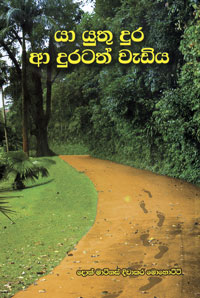 Divakara Mohotti commences his multi faceted novelette with a very
parenthetical phrase. I shall quote Divakara Mohotti commences his multi faceted novelette with a very
parenthetical phrase. I shall quote
 The Epistle that Mohotti is unravelling, visually unfolds a syndrome far and
wide, Symbolling that unique educational institution Sri Palee founded
by the late Wilmot A. Perera, Philanthropist with the live presence and
blessings of that Indian sage and poet Pandit Shri Rabindranath Tagore
and Mohotti is one of those products of that magnificent institution
which is now a cultural university The Epistle that Mohotti is unravelling, visually unfolds a syndrome far and
wide, Symbolling that unique educational institution Sri Palee founded
by the late Wilmot A. Perera, Philanthropist with the live presence and
blessings of that Indian sage and poet Pandit Shri Rabindranath Tagore
and Mohotti is one of those products of that magnificent institution
which is now a cultural university  idolises
also Prof. G.P. Ariyarathne, the neon Chomsky-like linguist who later
became the head of the English department of the university of Kelaniya. idolises
also Prof. G.P. Ariyarathne, the neon Chomsky-like linguist who later
became the head of the English department of the university of Kelaniya.
Social Change takes many forms in modern society and people are
affected by it in several different ways. For example in the past a
manâs prestige as much of his occupation in his work. However signs
indicate that the traditional basis for satisfaction is changing. This
change in attitude towards work stems not only from the character of
duties, but also from the character of duties that brings forth higher
income. This reverberant lyric that eulogizes Sri Palee, Mohotti recalls
with intensifying reverence.
 I would like to refer to the innate/talent of the author Divakara Mohotti,
when Gunadasa Liyanage burst out with this witty limerick.
I would like to refer to the innate/talent of the author Divakara Mohotti,
when Gunadasa Liyanage burst out with this witty limerick.
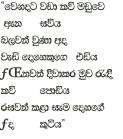 Divakaraâs attachment to his family is ever present throughout this
remarkable life- Story, not that he unlogirses like Dr. Samuel Johnson
who always burst in to bombastic lingua, though Johnson himself is a
master of the language. Divakaraâs attachment to his family is ever present throughout this
remarkable life- Story, not that he unlogirses like Dr. Samuel Johnson
who always burst in to bombastic lingua, though Johnson himself is a
master of the language.
Mohottiâs prose comes in with inherent ease. If I may quote,
Sometimes I felt the reverberating preface Stands some comparison with
the opening passage in our doyen of letters, Martin Wickremasingheâs
some what Controversial work  (conquest of the Cosmos)
(The father of Free Education) (conquest of the Cosmos)
(The father of Free Education)
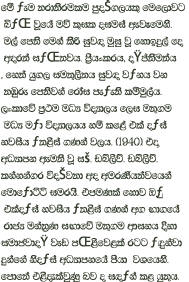
Divakaraâs Religions cognition is evident by his magnanimous
reverence to the Kalutara Bodhi Raja Dagoba and is vicinity.
âThe road is long and the pilgrim soon grown weary. The accumulated
karma of the past, which in its own inexorable time will offer itself
for cancelling, is a applying in the true sense of the word.â -Karma and
Birth Christmas Humphreys
- Dharmappriya |

